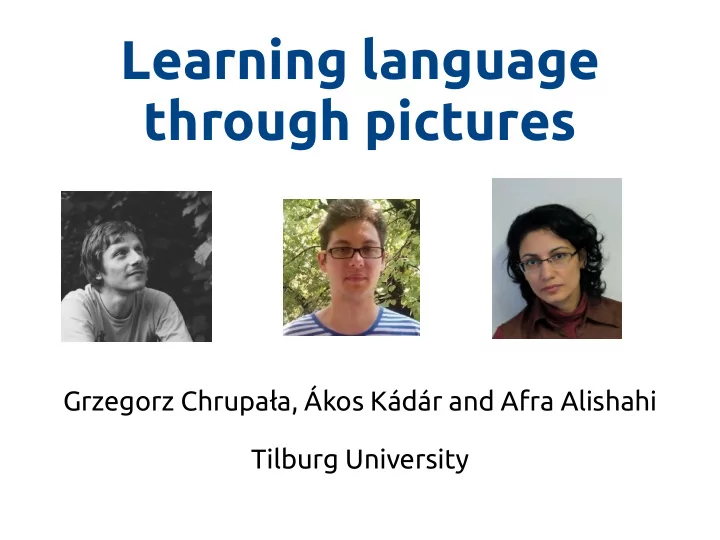

Learning language through pictures Grzegorz Chrupała, Ákos Kádár and Afra Alishahi Tilburg University
Word and phrase meanings Perceptual clues Distributional clues the cat sat on the mat the dog chased the cat funniest cat video ever lol
Real scenes Harder objects need to be identifjed invariances detected But also easier better opportunities for generalization
Cross-situational learning Synthetic data (Fazly et al. 2010) Utterance: a bird walks on a beam Scene: {bird, big, legs, walk, wooden, beam} “Coded” scene representations (Frank et al. 2009)
Cross-situational learning Synthetic data (Fazly et al. 2010) Utterance: a bird walks on a beam Scene: {bird, big, legs, walk, wooden, beam} “Coded” scene representations (Frank et al. 2009) Natural scenes not set of symbols
Captioned images Recent works on generating image descriptions use actual image features.
I MAGINET Multi-task language/image model Integrate linguistic and visual context Representations of phrases and complete sentences
Word Textual Visual Embeddings Pathway Pathway a bird walks CNN on a beam
Some details Shared word embeddings – 1024 units Pathways – Gated Recurrent Unit nets 1024 clipped rectifjer units Image representations: 4096 dimensions Multi-task objective
Multi-task objective L T – cross-entropy loss L V – mean squared error Three versions α = 0 – purely visual model α = 1 – purely textual model 0 < α < 1 – multi-task model
Bag-of-words linear regression as a baseline Baseline Input: word-count vector Output: image vector L2-penalized sum-of-squared errors regression
Correlations with human judgments SIMLEX MEN
Image retrieval task Embed caption in visual space Rank images according to cosine similarity to caption
Image retrieval and sentence structure Original versus scrambled captions
a brown teddy bear lying on top of a dry grass covered ground a a of covered laying bear on brown grass top teddy ground . dry
a variety of kitchen utensils hanging from a UNK board . kitchen of from hanging UNK variety a board utensils a .
Paraphrase retrieval Record the fjnal state along the visual pathway for a caption For each caption, rank others according to cosine similarity Are top-ranked captions about the same image?
Paraphrase retrieval
a cute baby playing with a cell phone small baby smiling at camera and talking on phone . a smiling baby holding a cell phone up to ear . a little baby with blue eyes talking on a phone . phone playing cute cell a with baby a someone is using their phone to send a text or play a game . a camera is placed next to a cellular phone . a person that 's holding a mobile phone device
Imaginet: Learns visually-grounded word and sentence representations from multimodal data Encodes and uses aspects of linguistic structure
Current & future work Understand internal states Poster at EMNLP VL2015 Character level modeling
Thanks!
Compared to compositional distributional semantics word embeddings distributional word vectors hidden states sentence vectors input-to-hidden weights projection to sentence space hidden-to-hidden weights composition operator All these are learned based on supervision signal from the two tasks
Compared to captioning Captioning (e.g. Vinyals et al. 2014) Start with image vector Output caption word-by-word conditioning on image and seen words I MAGINET Read caption word-by-word Incrementally build sentence representation while also predicting the coming word Finally, map to image vector
Long term Character-level input proof of concept working Direct audio input Need better story on what should be learned from data what should be hard-coded, or evolved
Gated recurrent units
I MAGINET
Recommend
More recommend